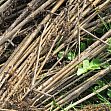Research and Projects
Overview
- DiP - iQ-Hemp - Digitalization in Quality Management of the Industrial Hemp Value Chain
- Hochdurchsatzanalyse der Formeigenschaften von Pavement-Zellen
- Automatic segmentation of plant roots in minirhizotron images
- rhizoTrak: A new software tool for manual annotation of images from minirhizotrons
- Detection and Tracking of Sub-cellular Structures in Microscope Images
- Segmentation of Cell Images with Active Contours
- Alida and MiToBo
DiP - iQ-Hemp - Digitalization in Quality Management of the Industrial Hemp Value Chain

In this project we are working on automatic, image-based quality accessment of industrial hemp along the complete value chain. The chain starts with the roast period on the field and includes the processing of the straw up to fibers and shives. Our goal is to automatically and objectively access the roast level using modern techniques of machine learning and artificial intelligence. Together with our partners from the agriculture we aim to support local producer and factories in Saxony-Anhalt in establishing economically sustainable concepts for cultivation and further processing of industrial hemp.
DiP - iQ-Hemp is part of DiP Saxony-Anhalt Model Region of Bioeconomics .
Duration: 01.04.2024 - 31.12.2028
Funding: Bundesministerium für BIldung und Forschung (BMBF)
Project partners:
- Prof. Janna Macholdt (project coordination), Department of Agronomy and Organic Farming, Institute of Agricultural and Nutritional Sciences of the Martin Luther University Halle-Wittenberg
Additional partners:
Further informationen und links:
- project website
- info page of DiP - iQ-Hemp at DiP
Hochdurchsatzanalyse der Formeigenschaften von Pavement-Zellen
Das Ziel dieses Projektes ist die effiziente Analyse von Formmerkmalen von Zellen. In erster Linie schauen wir uns dabei Pavement-Zellen an, aber die entwickelte Methodik eignet sich prinzipiell für beliebige Zelltypen. Wir haben dazu ein neues Tool zur Hochdurchsatz-Analyse von Pavement-Zellen veröffentlicht, PaCeQuant, das Zellen in Mikroskopbildern automatisch segmentiert und automatisch eine Reihe von Formparametern extrahiert. Im Vergleich zu früher verfügbaren Tools erlaubt der integrierte Segmentierungsansatz dabei, auf einen zeitaufwändigen manuellen Annotationsschritt zu verzichten und größere, repräsentativere Datensätze als bislang üblich zu analysieren.
Publikationen:
- D. Mitra, S. Klemm, P. Kumari, J. Quegwer, B. Möller, Y. Poeschl, P. Pflug, G. Stamm, S. Abel, K. Bürstenbinder, ''Microtubule-associated protein IQ67 DOMAIN5 regulates morphogenesis of leaf pavement cells in Arabidopsis thaliana'', Journal of Experimental Botany, 70(2):529-543, January 2019.
- PaCeQuant: A Tool for High-Throughput Quantification of Pavement Cell Shape Characteristics ,
Kooperationspartner:
- Dr. Katharina Bürstenbinder , Department of Molecular Signal Processing, Leibniz Institute of Plant Biochemistry, Halle (Pressemitteilung des IPB )
- Dr. Yvonne Pöschl , Institute of Computer Science, Martin Luther University Halle-Wittenberg & German Integrative Research Center for Biodiversity (iDiv) Halle-Jena-Leipzig, Leipzig
PaCeQuant ist als Teil von MiToBo und damit als Erweiterung für ImageJ/Fiji implementiert.
- MiToBo website
- Homepage von PaCeQuant
Automatic segmentation of plant roots in minirhizotron images

Minirhizotron image with segmentation results
Roots are an important organ of terrestrial plants as they provide vital functions. These include anchorage in the soil, resource uptake, -transport, and -storage. There is an intrinsical linkage to root production and mortality, accordingly root development is studied in biological research questions.
Minirhizotron systems are a non-destructive method of root measurement. They allow scientists to acquire images of roots directly in the soil and over time. Extracting the relevant data from the images, like root length and diameter, requires a precise root annotation. However, manual root annotation is a very time consuming and laborious task.
The aim of the project is to develop an automatic image segmentation procedure, which enables root detection in shorter time and with less (manual) effort. To achieve this we use different approaches like detection of relevant features, especially edges, and machine learning methods, e.g. deep learning. One big challenge is the inhomogenity of the soil as well as its water inclusions. Due to this the distinction between roots and soil gets more complicated even in manual annotation, while it makes an automatic root detection considerably more difficult.
The development of a reliable automatic root segmentation would enable the research community in biology to analyse more and bigger data sets in a resource efficent way and consequently helps to investigate biological relationships in plants to a greater extend.
Cooperations:
PD Dr. Alexandra Weigelt and Dr. Hongmei Chen,
Dept. of Systematic Botany and Functional Biodiversity,
Institute of Biology, Leipzig University
rhizoTrak: A new software tool for manual annotation of images from minirhizotrons

Minirhizotrons are a non-destructive way to monitor root growth. Transparent tubes are installed in the soil and a scanner takes images in these tubes. Due to its non-destructiveness, the system makes it easy to acquire time-series images which results in a large amount of image data. To analyse these data, researchers need to annotate the images manually which requires extensive effort.
Existing annotation software often has limited support for time-series annotation. Therefore, we develop the open source tool "rhizoTrak" for user-friendly, efficient and flexible manual annotation of complex time-series minirhizotron images. rhizoTrak builds on TrakEM2 while extending it with specific functionality for root image annotation. The tool is realized as a Fiji plugin. rhizoTrak relies on open data formats which cannot only be used for further analysis and statistical evaluations, but above all yields the perfect basis for developing and integrating further techniques, such as automatic segmentation.
Further details:
rhizoTrak website, https://prbio-hub.github.io/rhizoTrak/
Detection and Tracking of Sub-cellular Structures in Microscope Images

Microscope images of fluorescently labeled sub-cellular structures play an important role in biomedical research. They are of particular importance for understanding system processes within singular cells and their changes under varying environmental conditions. Relevant structures, like stress granules or p-bodies, show a large variation in their specific properties, e.g. in size or homogenity. Consequently techniques for automatic segmentation of these structures in microscope images likewise require a large flexibility and adaptivity. Amongst others we use adaptive algorithms based on wavelets to tackle this task. For tracking particles in videos they are combined with probabilistic filtering techniques.
Cooperations:
Section Molecular Cell Biology, Martin Luther University Halle-Wittenberg, Prof. Dr. Stefan Hüttelmaier
Segmentation of Cell Images with Active Contours

Single cells within large cell populations show a significant variety in their specific properties and behaviours, hence, large data sets need to be analyzed in biomedical research to cover the natural variation sufficiently well. Thereby in particular specifics of single cells are of high interest, and consequently qualitative as well as quantitative analysis steps, like the detection of sub-cellular structures, should always be done for individual cells. Indeed this requires the exact localization of single cells in populations and an exact segmentation of their contours. We solve this problem for a variety of different kinds of cells, amongst others also for neuronal cells, by adopting active contours (levelsets as well as snakes) and corresponding energy functionals.
Cooperations:
Section Molecular Cell Biology, Martin Luther University Halle-Wittenberg, Prof. Dr. Stefan Hüttelmaier
Alida and MiToBo

One important goal in our algorithm development is a large flexibility and also modularity to allow for easy reuse of developed components. At the same time implemented techniques are usually handed over to non-expert users immediately, hence, not only the algorithms by themselves, but likewise adequate user interfaces have to be provided. To this end we have developed a concept for an integrated development of functionality and user interfaces in data analysis named Alida (''Advanced Library for Integrated Development of Data Analysis Applications''). Alida defines a standard for implementing and executing data analysis operators, and by this supports amongst others the automatic generation of user interfaces and an automatic logging and documentation of analysis procedures.
Alida has been implemented in Java and prototypically in C++. The Java implementation serves as base for MiToBo, ''A Microscope Image Analysis Toolbox'', where our algorithms for microscope image analysis are collected. MiToBo subsumes operators for basic image processing like filters or morphological operators, and also more complex approaches like active contours or wavelets. In addition, specialized applications, e.g. for segmenting scratch assay images, are provided. MiToBo is based on ImageJ and fully compatible with the wide-spread software package.
More information: http://www.informatik.uni-halle.de/alida and http://www.informatik.uni-halle.de/mitobo




